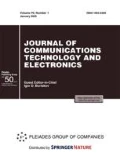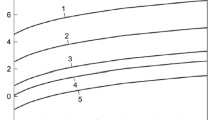Abstract
An algorithm for measuring the Muller matrix of a radar target using non-polarized probing signals is presented. Estimates are obtained for the measurement error of polarization characteristics depending on the orientation angles and ellipticity of irradiating radio signals. An algorithm for eliminating the influence of the transmitting and receiving radar antennas on the result of measuring the polarization characteristics of radar targets using a radar reflector with switchable polarization properties is described. The results of numerical calculation of the Muller matrix of dihedral corner and non-reciprocal reflectors before and after compensation for the influence of transmitting and receiving antennas on the measured polarization characteristics are presented.

Similar content being viewed by others
REFERENCES
A. I. Kozlov, A. I. Logvin, and V. A. Sarychev, Polarization of Radio Waves, Vol. 2: Radar Polarimetry (Radiotekhnika, Moscow, 2007) [in Russian].
A. I. Kozlov, A. I. Logvin, and V. A. Sarychev, Polarization of Radio Waves Vol. 3: Radio Polarimetry of Signals, Difficult on Structure (Radiotekhnika, Moscow, 2008) [in Russian].
D. B. Kanareikin, N. F. Pavlov, and V. A. Potekhin, Polarization of Radar Signals (Sovetskoe Radio, Moscow, 1966) [in Russian].
K. G. Gusev, A. D. Filatov, and A. P. Sopolev, Polarizing Modulation (Sovetskoe Radio, Moscow, 1974) [in Russian].
B. V. Kaul’ and I. V. Samokhvalov, Regional Monitoring of the Atmosphere. Part 2: New Devices and Measurement Techniques, Ed. by M. V. Kabanov (Spektr, Tomsk, 1997), p. 34 [in Russian].
S. H. Yueh, J. A. Kong, R. M. Barnes, and R. T. Shin, J. Electromagn. Waves & Appl. 4 (1), 27 (1990).
Y. Izumi1, S. Demirci, and M. Z. Baharuddin, et al., Prog. in Electromagn. Res. B 73, 79 (2017).
E. L. Shoshin, Izmer. Tekh., No. 3, 45 (2021).
E. L. Shoshin, Instrum. Exp. Tech., No. 6, 812 (2021).
V. N. Tatarinov, S. V. Tatarinov, and L. P. Ligtkhart, Introduction to the Modern Theory of Polarization of Radar Signals, Vol. 1: Polarization of Plane Electromagnetic Waves and Its Transformation (Tomsk. Gos. Univ., Tomsk, 2006) [in Russian].
H. C. Van De Hulst, Light Scattering by Small Particles (Dover, New York, 1981).
V. A. Khlusov, Opt. Atmosf. 8, 1441 (1995).
Author information
Authors and Affiliations
Corresponding author
Ethics declarations
The author declares that he has no conflicts of interest.
Rights and permissions
About this article
Cite this article
Shoshin, E.L. Methods for Measuring the Polarization Characteristics of Radar Targets Using Non-Polarized Radio Waves. J. Commun. Technol. Electron. 67, 1096–1104 (2022). https://doi.org/10.1134/S1064226922090145
Received:
Revised:
Accepted:
Published:
Issue Date:
DOI: https://doi.org/10.1134/S1064226922090145




